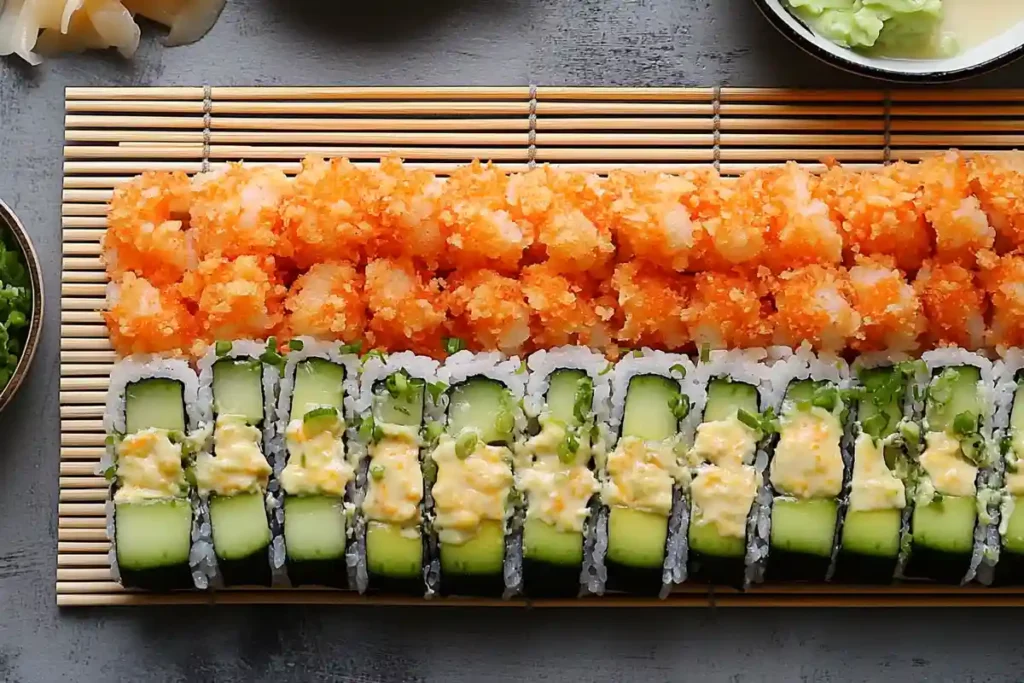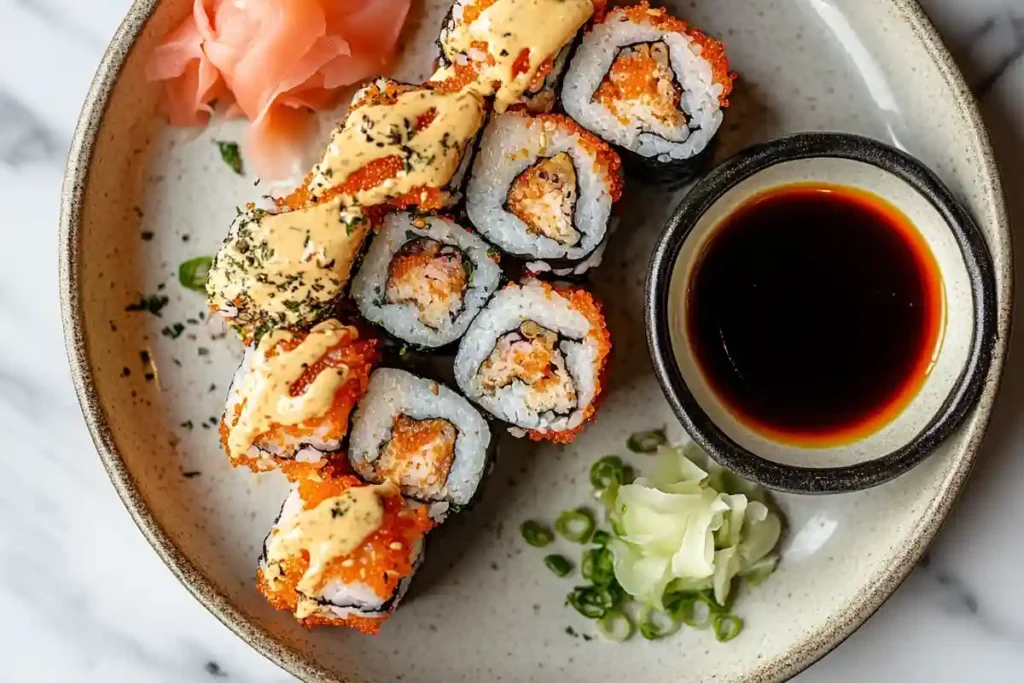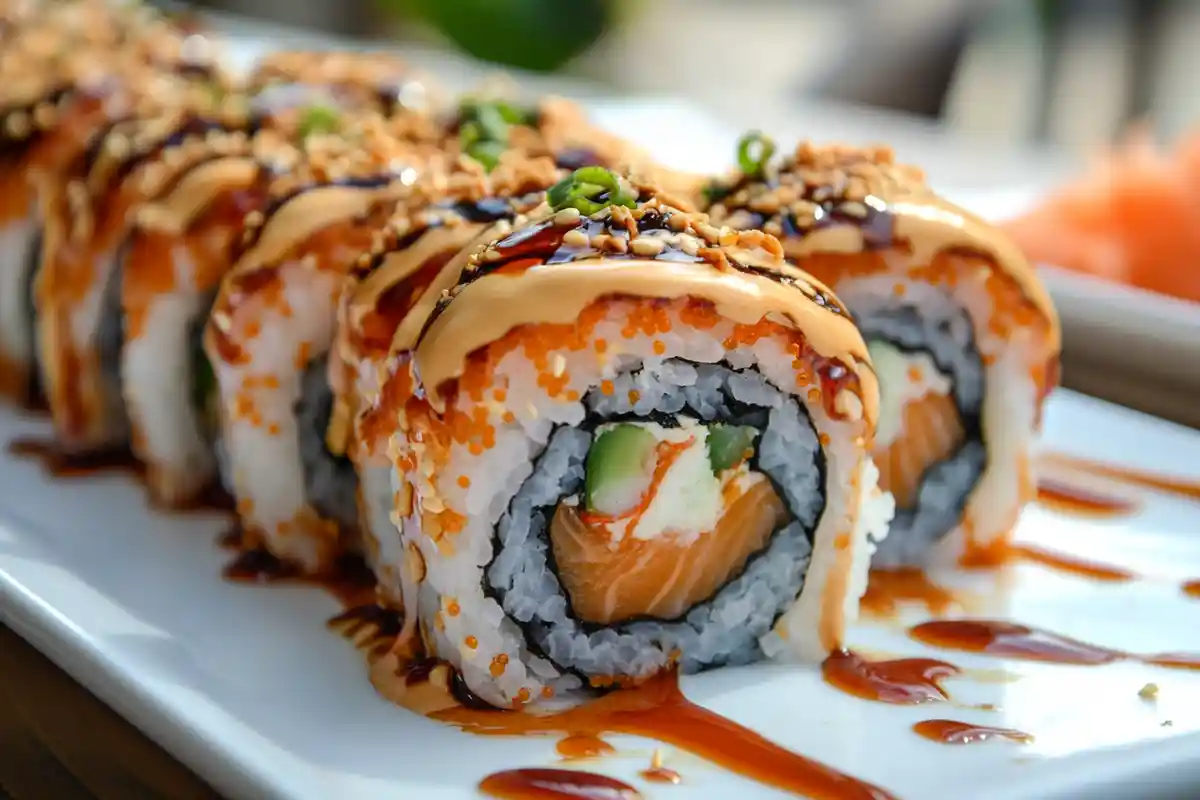Tiger Roll is both a popular sushi roll and a champion racehorse. Learn about its origins, variations, how to make it, and its racing history.
Understanding Tiger Roll
What Is in a Tiger Roll?
Tiger Roll sushi is one of those creations that instantly grabs attention—not just because of its delicious taste but also its striking appearance. This roll, a favorite at sushi restaurants, is known for its bold flavors and unique texture. While traditional sushi rolls lean on simplicity, the Tiger Roll brings a fusion of flavors that make it a standout choice. But what exactly goes into this sushi masterpiece?
Traditional Ingredients of a Tiger Roll
A classic Tiger Roll combines several key ingredients that contribute to its signature taste and look. At its core, it typically includes:
- Sushi Rice – Short-grain rice seasoned with rice vinegar, sugar, and salt for that perfect sticky texture.
- Nori (Seaweed) – A sheet of dried seaweed that holds the roll together.
- Tempura Shrimp – The star protein of the roll, deep-fried to a crispy golden brown.
- Cucumber – Adds a fresh crunch that balances the richness of the tempura shrimp.
- Avocado – Contributes creaminess, making each bite smooth and flavorful.
- Spicy Mayo – A mix of mayonnaise and sriracha, adding a subtle kick to the roll.
- Eel Sauce (Unagi Sauce) – A thick, sweet-savory sauce that enhances the umami factor.
- Tobiko or Masago – Tiny fish roe that gives the roll a pop of color and a slight crunch.
These ingredients work together to create a sushi roll that is crispy, creamy, and packed with umami flavors.
Variations and Regional Twists
While the traditional Tiger Roll is widely loved, many restaurants and chefs put their own spin on it. Some variations include:
- Spicy Tiger Roll – Includes extra sriracha or wasabi for a fiery kick.
- Dragon Tiger Roll – Features a topping of thinly sliced eel, adding a smoky depth.
- Vegan Tiger Roll – Uses crispy tempura tofu instead of shrimp, with an added layer of mango for sweetness.
- Crunchy Tiger Roll – Coated with extra tempura flakes for a satisfying crunch in every bite.
Each region and sushi chef brings their own take on the Tiger Roll, proving that sushi is as much about creativity as it is about tradition.
For those who enjoy experimenting with sushi ingredients, tobiko (flying fish roe) adds a delightful crunch and burst of umami. Learn more about tobiko and its role in sushi.
Why Is It Called Tiger Roll Sushi?
At first glance, the name “Tiger Roll” might seem random, but there’s actually a reason behind it. Let’s break it down.
Origin of the Name
The name “Tiger Roll” comes from the roll’s visual appeal and its layered flavors. Sushi chefs wanted to create a roll that stood out, much like the majestic tiger in the wild. Since this roll often features an outer layer of shrimp and sauces that resemble tiger stripes, the name was a natural fit.
Some also say the name is linked to its bold flavors—spicy mayo, sweet eel sauce, and crispy shrimp create a taste that’s as fierce as a tiger’s roar!
Influence of Tiger Stripes on Presentation
One of the most eye-catching aspects of the Tiger Roll is its resemblance to a tiger’s striped fur. This effect is usually achieved by drizzling eel sauce in thin lines over the roll, mimicking the stripes of a tiger. Sometimes, sushi chefs use alternating layers of shrimp and avocado to create a similar visual.
This attention to presentation is part of what makes sushi an art form. Every detail, from the placement of ingredients to the final garnish, contributes to the experience.
The Popularity of Tiger Roll in Sushi Culture
Sushi culture is vast, with hundreds of different rolls and styles. Yet, the Tiger Roll has secured a top spot in many sushi restaurants. Why? Let’s find out.
How It Became a Sushi Staple
The Tiger Roll became popular because it appeals to both sushi beginners and seasoned sushi lovers. Here’s why:
- Texture and Flavor Balance – The crispy shrimp, creamy avocado, and slightly spicy mayo create a well-balanced bite.
- No Raw Fish – Unlike traditional sushi, the Tiger Roll features cooked shrimp, making it a go-to for those hesitant about raw fish.
- Visually Stunning – The “tiger stripes” make it an Instagram-worthy dish.
- Fusion-Friendly – It blends traditional sushi techniques with modern flavors, making it accessible to a broader audience.
Thanks to these factors, the Tiger Roll has earned its place alongside classics like the California Roll and Spicy Tuna Roll.
Differences Between Tiger Roll and Other Sushi Rolls
Not all sushi rolls are created equal. Here’s how the Tiger Roll compares to other popular sushi rolls:
| Sushi Roll | Key Ingredients | Main Difference |
|---|---|---|
| Tiger Roll | Tempura shrimp, avocado, cucumber, spicy mayo, eel sauce | Crispy texture, tiger-striped look |
| California Roll | Imitation crab, avocado, cucumber | No tempura, mild flavor |
| Spicy Tuna Roll | Raw tuna, spicy mayo, cucumber | Spicy and raw, no crunch |
| Dragon Roll | Eel, avocado, cucumber, eel sauce | Features grilled eel, rich flavor |
| Philadelphia Roll | Smoked salmon, cream cheese, cucumber | Creamy and smoky taste |
While other rolls focus on raw fish or minimal ingredients, the Tiger Roll stands out with its crispy texture, bold flavors, and artistic presentation.
Who Is Tiger Roll in the World of Horse Racing?
Not to be confused with the sushi roll, Tiger Roll is also one of the most legendary racehorses in modern history. Known for his incredible stamina, agility, and back-to-back Grand National victories, this horse has left a lasting mark on the racing world. But where did his journey begin?
Background and Early Life
Birth and Breeding Details
Tiger Roll was born on March 14, 2010, in Ireland. His pedigree boasts a strong lineage, with his sire (Authorized) being a Derby-winning horse, known for producing top-class stayers. His dam (Swiss Roll) also had a respectable racing background, making it clear from the start that Tiger Roll had the potential to be a champion.
Bred for long-distance races, he had the natural athleticism and endurance needed for the toughest courses. However, no one could have predicted just how far he would go in his career.
Ownership and Racing Stables
Tiger Roll’s ownership history is also an interesting part of his story. Initially, he was purchased by Godolphin, a well-known horse racing operation, but he was later sold as a three-year-old to trainer Nigel Hawke. Under Hawke’s guidance, he won his first race in impressive fashion.
Not long after, Gordon Elliott, one of Ireland’s most successful trainers, took over Tiger Roll’s training. The horse was then acquired by Gigginstown House Stud, owned by Michael O’Leary (yes, the same Michael O’Leary who runs Ryanair). This change set Tiger Roll on a path to greatness, as Elliott carefully nurtured his talent.
Career Achievements of Tiger Roll

Tiger Roll wasn’t just another racehorse—he was a once-in-a-generation talent. His career spanned over a decade, during which he competed in some of the world’s most grueling races.
Major Races and Wins
Tiger Roll made an early impact in his racing career. Some of his biggest victories include:
- 2014 Triumph Hurdle (Cheltenham Festival) – His first major win at the prestigious Cheltenham Festival.
- 2017 National Hunt Chase Challenge Cup – Showed his staying power with a thrilling victory.
- 2018 Glenfarclas Cross Country Chase (Cheltenham) – Proved his versatility on unique cross-country courses.
- 2019 Glenfarclas Cross Country Chase (Cheltenham) – Defended his title in dominant fashion.
However, his most famous wins came in the world’s most challenging steeplechase event—the Grand National.
Grand National Victories
The Grand National is often called the “ultimate test of a racehorse,” featuring 30 jumps over a four-mile course. Many horses try, but few ever conquer it.
Tiger Roll not only won the Grand National but did so twice in a row, a feat last achieved by Red Rum in the 1970s.
- 2018 Grand National – Won by three lengths, showing an incredible burst of speed at the finish.
- 2019 Grand National – Became the first back-to-back winner since Red Rum, cementing his place in history.
After this historic double victory, fans began calling him “the modern-day Red Rum.” His small size (for a racehorse) and big heart made him a fan favorite.
What Does Tiger Roll Do Now?
All great careers eventually come to an end, and after years of thrilling victories, Tiger Roll’s racing days had to conclude.
Retirement and Current Status
Tiger Roll officially retired from racing after the 2022 Cheltenham Festival. His final race was emotional, as fans cheered him on one last time. While he didn’t win, he had already secured his legendary status.
Post-retirement, Tiger Roll now enjoys a more relaxed life. Unlike many retired racehorses who transition into new disciplines like show jumping or dressage, Tiger Roll is simply enjoying life at Gigginstown House Stud. His owners and fans make sure he’s well taken care of, and he often makes public appearances at racing events.
Legacy in Horse Racing History
Tiger Roll’s impact on horse racing goes beyond his victories. He changed the way people view small horses in big races, proving that heart and determination matter more than size.
His legacy includes:
- Being one of the most beloved Grand National winners in history.
- Boosting the popularity of cross-country and steeplechase racing.
- Showing that a horse doesn’t have to be bred specifically for the Grand National to win it twice.
- Inspiring a new generation of racing fans and trainers.
Even though he’s no longer competing, his influence remains strong. People still talk about his back-to-back Grand National wins, and many young racehorses are now compared to him.
Tiger Roll in Modern Sushi Trends
While Tiger Roll has made a name for itself in horse racing, its sushi counterpart is just as famous in the culinary world. Found on sushi menus worldwide, this roll continues to be a favorite for both beginners and seasoned sushi lovers. But what makes it stand out? And more importantly, how can you make one at home?
How to Make a Tiger Roll at Home

Making sushi at home might sound intimidating, but the Tiger Roll is surprisingly beginner-friendly. With the right ingredients and a little patience, you can create this restaurant-quality roll in your own kitchen.
Using high-quality cheese can elevate your homemade sushi experience. Try incorporating a mild, creamy cheese like Gruyère for a unique twist. Check out our Gruyère cheese guide to learn more.
Essential Ingredients and Preparation Steps
Before rolling up your sushi, make sure you have these key ingredients:
- 2 cups sushi rice (cooked and seasoned with rice vinegar, sugar, and salt)
- 4 sheets nori (seaweed)
- 6 tempura shrimp (store-bought or homemade)
- 1 cucumber (thinly sliced)
- 1 avocado (sliced)
- 1/2 cup spicy mayo (mix mayo and sriracha to taste)
- 1/4 cup eel sauce (available at most Asian markets)
- 1/4 cup tobiko or masago (optional, for topping)
- Sesame seeds (for garnish)
Steps to make a Tiger Roll:
- Prepare the rice – Rinse and cook the sushi rice. Once cooled, season it with rice vinegar, sugar, and salt.
- Fry the shrimp – If making tempura shrimp at home, dip them in tempura batter and fry until crispy. Let them drain on a paper towel.
- Lay out the nori – Place a sheet of nori on a bamboo sushi mat, shiny side down.
- Spread the rice – Wet your fingers and gently spread an even layer of sushi rice over the nori.
- Flip the nori – Carefully turn the nori sheet over so the rice side is facing down.
- Add fillings – Place tempura shrimp, cucumber, and avocado along the bottom edge of the nori.
- Roll it up – Using the bamboo mat, roll the sushi tightly from bottom to top, applying gentle pressure.
- Slice and top – Cut the roll into pieces, drizzle with spicy mayo and eel sauce, then sprinkle with tobiko or masago.
- Serve and enjoy!
Tips for Perfecting the Roll
- Use a sharp knife – Dip it in water before slicing to prevent sticking.
- Don’t overfill – Too many ingredients make rolling difficult.
- Chill the roll before cutting – This helps keep the shape intact.
- Practice makes perfect – If your first roll isn’t perfect, don’t worry! Sushi rolling improves with time.
Tiger Roll in Restaurants and Fusion Cuisine
The Tiger Roll isn’t just a homemade delight—it’s also a star on sushi menus worldwide.
Common Pairings and Complementary Dishes
Restaurants often serve Tiger Rolls with:
- Miso Soup – A warm, comforting contrast to the cold sushi.
- Edamame – Lightly salted soybeans that balance out the richness of the roll.
- Seaweed Salad – Adds a fresh, tangy crunch.
- Sake or Green Tea – Complements the flavors of the sushi.
For those who love a little extra heat, pairing a Tiger Roll with a side of wasabi and pickled ginger adds an extra punch.
Global Influence on Sushi Culture
While sushi originated in Japan, rolls like the Tiger Roll are examples of global fusion cuisine. These Western-style rolls incorporate creative ingredients like tempura, spicy mayo, and even cream cheese, which are rarely found in traditional Japanese sushi.
In the same way that the California Roll introduced sushi to the American mainstream, the Tiger Roll represents the evolution of sushi in global dining culture. Sushi chefs continue to experiment, creating new versions of the roll with unique toppings and flavors.
Health and Nutritional Aspects of Tiger Roll
Sushi is often seen as a healthy meal option, but what about the Tiger Roll? Let’s break down its nutritional value.
If you’re looking for more protein-packed meal options, explore our 30-gram protein breakfast guide for nutritious ways to start your day.
Calories and Nutritional Breakdown
Here’s an approximate nutritional profile for one serving (about 8 pieces) of Tiger Roll sushi:
| Nutrient | Amount per serving |
|---|---|
| Calories | 400–500 kcal |
| Protein | 20g |
| Carbohydrates | 55g |
| Fats | 15g |
| Sodium | 900mg |
Because of the tempura shrimp and spicy mayo, the Tiger Roll is slightly higher in calories and fat compared to simpler sushi rolls like tuna or cucumber rolls. However, it also provides a good amount of protein and healthy fats from the avocado.
Dietary Considerations and Substitutes
If you’re looking to make the Tiger Roll a bit healthier, here are some modifications:
- Lower calorie option – Use grilled shrimp instead of tempura.
- Gluten-free alternative – Swap soy sauce for tamari and use gluten-free tempura batter.
- Vegan version – Replace shrimp with tempura sweet potato or tofu.
- Lower sodium – Reduce eel sauce and opt for low-sodium soy sauce.
While the Tiger Roll may not be the lightest sushi roll, it’s a great option for those looking for a delicious, satisfying sushi experience.
FAQs About Tiger Roll

What Age Is Tiger Roll (the Horse)?
Tiger Roll was born on March 14, 2010, which means he turned 15 years old in 2025. While no longer racing, he remains a beloved figure in the horse racing world, enjoying retirement at Gigginstown House Stud.
Why Is Tiger Roll a Popular Sushi Choice?
Tiger Roll is a fan-favorite because it’s a perfect balance of textures and flavors. The crispy tempura shrimp contrasts beautifully with the creamy avocado, while spicy mayo and eel sauce add layers of rich, savory goodness. Plus, it’s a great option for those who prefer cooked sushi over raw fish!
How Does Tiger Roll Differ from Other Sushi Rolls?
Tiger Roll stands out due to its tempura shrimp filling and unique “tiger-striped” presentation. Unlike simple sushi rolls like the California Roll (which uses imitation crab) or Spicy Tuna Roll (which features raw tuna), the Tiger Roll is a fusion creation, blending crispy, creamy, and spicy elements in every bite.
Where Can You Find the Best Tiger Roll?
The best Tiger Rolls can be found at high-quality sushi restaurants that specialize in fusion sushi. If you’re looking for a great one, try:
- Japanese fusion restaurants – They often put creative spins on classic rolls.
- Local sushi bars – Some places have signature versions of the Tiger Roll.
- Specialty sushi chains – Restaurants like Nobu and Sushi Roku serve elevated versions of this roll.
If unsure, always check online reviews to find a top-rated sushi spot near you!
How Did Tiger Roll Become Famous in Horse Racing?
Tiger Roll became legendary after winning back-to-back Grand Nationals in 2018 and 2019, a feat last achieved by Red Rum in the 1970s. His small stature, impressive stamina, and fearless jumping ability made him a racing icon.
Can You Make a Vegan Version of Tiger Roll?
Absolutely! A plant-based Tiger Roll can be just as delicious. Some great substitutes include:
- Tempura sweet potato or tofu instead of shrimp.
- Vegan spicy mayo (made with plant-based mayo and sriracha).
- Avocado and cucumber for the classic creamy-crunchy contrast.
This version keeps the signature flavors while being 100% vegan-friendly.
What Are the Best Dipping Sauces for Tiger Roll?
Tiger Roll pairs well with various sauces to enhance its flavors. Popular options include:
- Spicy Mayo – A creamy, spicy kick.
- Eel Sauce – A sweet, umami-rich glaze.
- Ponzu Sauce – A citrusy, soy-based dip.
- Wasabi Soy Sauce – For those who love extra heat.
Each sauce adds a unique touch, making every bite even more flavorful.

